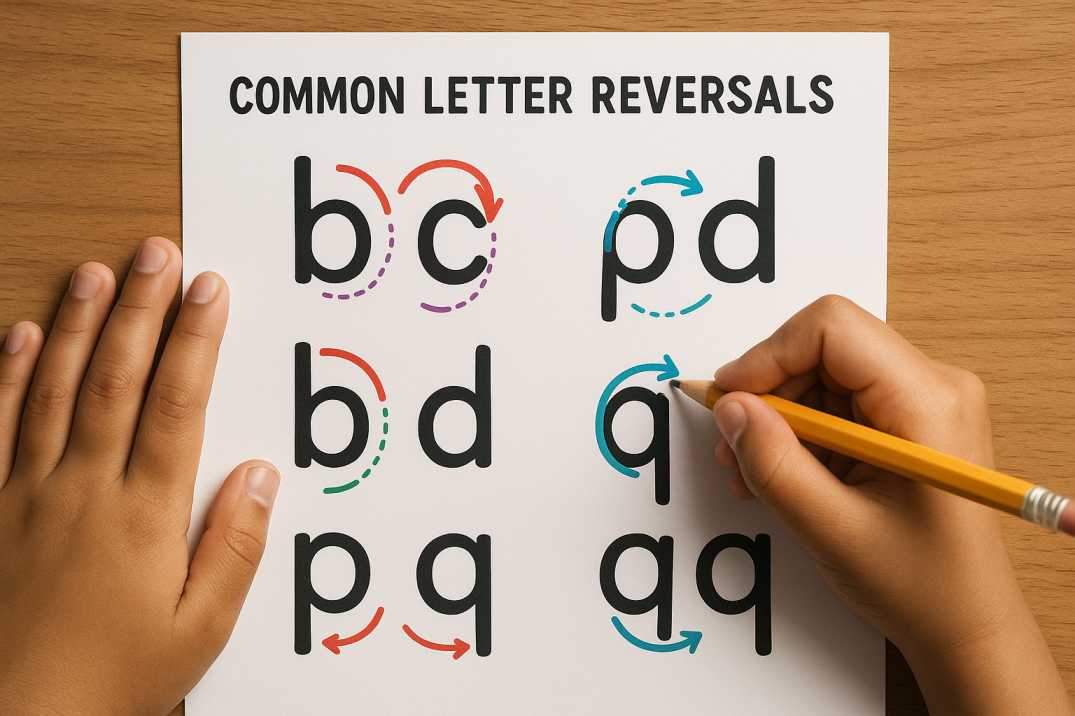Is Writing Backwards a Sign of Vision Problems? Expert Guide

TL;DR – Quick Answers
Writing backward is common in children under age 7 and usually resolves naturally as reading and writing skills develop. However, persistent letter reversals beyond age 7-8 may indicate underlying vision problems affecting visual processing, laterality, and directionality—not just dyslexia. Vision therapy can effectively address these visual skill deficits and help children overcome letter reversals when vision problems are the root cause.
When your child brings home schoolwork with “b” written as “d” or their name spelled backward, it’s natural to feel concerned. Is this a sign of dyslexia? Could there be a vision problem? Should you wait and see, or seek professional help now?
You’re not alone in these worries. Many parents notice their children writing backward and immediately fear the worst. The truth is more nuanced—and more hopeful—than you might think.
Bottom Line: While letter reversals are a normal part of early writing development, they can also signal treatable vision problems that affect how your child processes visual information. Understanding the difference between typical development, dyslexia, and vision-based learning challenges is the first step toward helping your child succeed.
In this comprehensive guide, we’ll explore the relationship between writing backward and vision problems, when to be concerned, and what treatment options really work.
What Is Mirror Writing and Letter Reversals?
Defining the Terms
Mirror writing refers to writing letters, numbers, or words in reverse—as if looking at normal text in a mirror. The most common examples include:
Letter reversals:
- Writing “b” as “d” (and vice versa)
- Confusing “p” and “q”
- Flipping “s” backward
- Reversing “n” to “u”
Number reversals:
- Writing “2” backwards
- Reversing “3,” “5,” “7,” or “9”
Word reversals:
- Reading or writing “was” as “saw”
- Spelling “dog” as “god”
These reversals can occur when reading, writing, or both. Sometimes children write entire words or sentences from right to left, creating text that can only be read easily when held up to a mirror.
Why Children Write Letters Backward
The fascinating neuroscience behind mirror writing reveals that our brains weren’t designed for reading and writing—these are learned skills we’ve adapted over thousands of years of human development.
Young children’s brains use a process called mirror generalization, which helps them recognize objects regardless of orientation. A cup is still a cup whether you view it from the left or right side. This survival mechanism helps us quickly identify important objects (or threats) from any angle.
However, letters are unique. A “b” flipped becomes a “d”—an entirely different letter. Children must unlearn this natural mirror generalization tendency and recognize that orientation matters for letters, even though it doesn’t for most other objects they encounter.
Normal Developmental Stages
Ages 3-5 (Preschool):
- Letter reversals are extremely common and expected
- Children are just learning letter shapes and sounds
- Writing direction is still being established
Ages 5-7 (Kindergarten-1st Grade):
- Occasional reversals remain normal
- Most children gradually self-correct with practice
- Reading and writing experience helps solidify correct letter formation
Ages 7-8 and Beyond (2nd Grade+):
- Persistent reversals become concerning
- May indicate underlying learning or vision challenges
- Professional evaluation recommended
Research shows that approximately 30% of children experience some letter reversals during early literacy development. Most naturally outgrow this phase by second grade without intervention.
The Vision Connection: How Vision Problems Cause Writing Backwards
Beyond 20/20 Vision
Many parents are surprised to learn that their child can have perfect 20/20 eyesight and still have significant vision problems that affect learning. Standard vision screenings test visual acuity—the ability to see clearly at a distance—but miss the complex visual skills needed for reading and writing.
Vision problems that cause letter reversals involve how the eyes work together and how the brain processes visual information. These functional vision issues can directly lead to writing backward, even in intelligent, capable children.
Visual Processing: The Missing Link
Visual processing refers to the brain’s ability to interpret and make sense of what the eyes see. When visual processing is impaired, children may:
- Struggle to remember what letters look like
- Have difficulty distinguishing between similar letters
- Confuse the orientation of letters (left vs. right facing)
- Reverse the direction of entire words
This isn’t about “seeing” incorrectly—it’s about interpreting visual information. The eyes may capture the image perfectly, but the brain processes it in a way that leads to reversals.
Laterality and Directionality: Critical Visual Skills
Two specific visual skills play a major role in preventing letter reversals:
Laterality is the internal sense of knowing right from left on your own body. For example, knowing which hand to place over your heart during the Pledge of Allegiance. Children with poor laterality struggle to establish a consistent frame of reference for directionality.
Directionality is the ability to project right and left onto external objects and space. This includes recognizing that:
- We read from left to right in English
- Letters face specific directions
- The sequence “b-d” is different from “d-b”
When laterality and directionality are underdeveloped, children lack the visual-spatial foundation needed to consistently write letters in the correct orientation.
Vision Problems That Cause Letter Reversals
Several specific vision conditions contribute to writing backward:
Convergence Insufficiency:
- Difficulty bringing eyes together to focus on near work
- Causes eye strain, double vision, or blurred text
- Makes it hard to maintain a clear, single vision while writing
Accommodative Dysfunction:
- Problems with focusing, especially when switching between distances
- Results in blurry or unstable visual images
- Impairs visual memory for letter shapes
- Difficulty smoothly following lines of text
- Loses place while reading or writing
- Contributes to confusion about letter and word order
Visual-Motor Integration Deficits:
- Difficulty coordinating what the eyes see with hand movements
- Struggles to reproduce letters accurately on paper
- May remember letter shapes but can’t execute them correctly
Visual Memory and Discrimination Weaknesses:
- Poor recall of how letters look
- Difficulty distinguishing between similar letters
- Confusion about distinctive features (which direction does “b” face?)
These vision problems often go undetected in standard eye exams because they don’t affect distance vision. They become apparent only when children face the visual demands of schoolwork.
Dyslexia vs. Vision Problems: Understanding the Difference
What Is Dyslexia?
Dyslexia is a language-based learning disability that affects how the brain processes written language. The International Dyslexia Association defines it as a neurological condition characterized by difficulties with:
- Accurate and fluent word recognition
- Poor spelling and decoding abilities
- Phonological processing (manipulating sounds in language)
Research indicates dyslexia affects approximately 15-20% of the population (some estimates range from 5-20% depending on diagnostic criteria), making it one of the most common learning disabilities. This translates to roughly 1 in 5 to 1 in 10 individuals experiencing some degree of dyslexia.
Critical distinction: Dyslexia is NOT a vision problem. Research consistently shows that people with dyslexia don’t actually “see” letters backward—they have difficulty connecting letter symbols to their corresponding sounds.
Key Signs of Dyslexia
Children with dyslexia typically exhibit:
- Difficulty rhyming or breaking words into syllables
- Trouble blending sounds to form words (c-a-t → “cat”)
- Slow, labored reading despite intelligence
- Poor spelling, especially phonetic spelling
- Avoidance of reading tasks
- Family history of reading difficulties
Comparison Table: Vision Problems vs. Dyslexia
| Feature | Vision Problems | Dyslexia |
|---|---|---|
| Root Cause | Visual processing and eye coordination issues | Phonological and language processing deficit |
| Primary Difficulty | Visual perception, eye tracking, and focus | Sound-letter connection, decoding words |
| Letter Reversals | Common, especially b/d, p/q | May occur, but not the primary issue |
| Reading Fluency | Slowed by visual strain and tracking problems | Slowed by decoding difficulties |
| Spelling | May be affected if visual memory is weak | Typically poor, especially phonetic patterns |
| Comprehension | Often good if the text is read aloud | May struggle with both reading and listening |
| Headaches/Eye Strain | Very common, especially during near work | Less common |
| Double/Blurry Vision | Frequent complaint | Rare |
| Phonological Awareness | Typically age-appropriate | Significantly delayed |
| Treatment | Vision therapy, corrective lenses, and visual training | Structured literacy programs, phonics-based reading instruction |
| Screening Test | Functional vision evaluation by a developmental optometrist | Educational psychology assessment, reading specialist evaluation |
Can Both Conditions Coexist?
Yes. Some children have both dyslexia and vision problems. When a child has been diagnosed with dyslexia but continues to struggle despite appropriate reading interventions, a comprehensive vision evaluation is strongly recommended.
Vision problems won’t cause dyslexia, but they can make dyslexia symptoms worse. Addressing vision issues in children with dyslexia can:
- Reduce visual discomfort during reading
- Improve attention and endurance for schoolwork
- Enhance visual processing efficiency
- Support overall learning
When Should Parents Be Concerned About Writing Backward?
Age-Appropriate Guidelines
Under Age 7: Usually Normal
Letter reversals before second grade are considered developmentally typical. Most children naturally outgrow this phase as they gain more reading and writing experience. During these early years, focus on:
- Gentle correction without criticism
- Plenty of reading practice
- Multisensory letter formation activities
- Positive reinforcement for effort
Ages 7-8: Monitor Carefully
If letter reversals persist into second grade, it’s time to pay closer attention. Watch for:
- Frequency of reversals (occasional vs. frequent)
- Whether reversals are improving or staying the same
- Other symptoms (reading struggles, headaches, avoidance)
- Impact on school performance and self-esteem
Age 8+: Seek Professional Evaluation
Consistent letter reversals beyond second grade warrant professional assessment. Don’t wait—early intervention produces the best outcomes.
Red Flags That Indicate a Problem
Beyond letter reversals, watch for these warning signs:
Visual Symptoms:
- Frequent headaches, especially after reading
- Complaints of words moving or blurring on the page
- Rubbing eyes often
- Closing or covering one eye while reading
- Holding books very close or at unusual angles
- Losing place frequently while reading
- Skipping lines or words
- Double vision
Reading and Writing Difficulties:
- Slow, labored reading speed
- Poor reading comprehension despite adequate decoding
- Avoidance of reading tasks
- Inconsistent word recognition (reads a word correctly, then misses it later)
- Letter or word omissions when copying
- Poor spacing between words and letters
- Messy, inconsistent handwriting
Academic and Behavioral Signs:
- Declining academic performance
- Homework is taking excessively long to complete
- Difficulty concentrating during visual tasks
- Complaints that schoolwork is “too hard” or “boring”
- Increased frustration or emotional distress about school
- Behavioral problems that emerge during reading/writing activities
Physical Signs:
- Poor posture while reading or writing
- Tilting head to one side
- Excessive blinking or squinting
- Dizziness or nausea after reading
- Balance or coordination difficulties
The Risk of “Wait and See”
Many well-meaning educators and healthcare providers suggest “waiting to see if they outgrow it.” While appropriate for very young children, this approach becomes problematic after age 7.
Why early intervention matters:
- The longer vision problems go unaddressed, the more a child falls behind academically
- Negative experiences create reading avoidance and lowered self-esteem
- Poor visual skills become habitual patterns that are harder to change
- Critical neuroplastic windows for vision development close as children age
- Academic gaps widen, requiring more intensive catch-up work later
If your child shows persistent letter reversals plus any of the warning signs above, schedule a comprehensive vision evaluation without delay.
Professional Assessment and Diagnosis
Functional Vision Evaluation
A functional vision exam goes far beyond standard vision screening. Performed by a developmental optometrist or vision therapist, this comprehensive assessment evaluates:
Eye Health and Visual Acuity:
- Basic eye health examination
- Distance and near visual clarity
- Refractive error (nearsightedness, farsightedness, astigmatism)
Binocular Vision Skills:
- Eye teaming and coordination
- Convergence and divergence ability
- Stereopsis (3D depth perception)
Eye Movement Control:
- Smooth pursuit (following moving objects)
- Saccades (jumping from point to point)
- Fixation stability
Focusing Skills:
- Accommodation accuracy and flexibility
- Ability to sustain focus over time
- Speed of focus changes
Visual Processing:
- Visual discrimination (telling similar letters apart)
- Visual memory (remembering letter shapes)
- Form constancy (recognizing letters in different fonts/sizes)
- Visual spatial skills (understanding position and orientation)
- Laterality and directionality
Visual-Motor Integration:
- Eye-hand coordination
- Ability to copy shapes and letters accurately
Testing Tools:
Common assessments include:
- Test of Visual Perceptual Skills (TVPS): Evaluates visual analysis abilities
- Jordan Right-Left Reversal Test: Assesses laterality and spatial orientation
- Developmental Eye Movement Test (DEM): Measures eye tracking accuracy and speed
- Near Point of Convergence: Tests the ability to maintain single vision at near distances
Educational Psychology Assessment
If dyslexia is suspected, an educational psychologist or reading specialist will conduct:
Phonological Awareness Testing:
- Sound manipulation tasks
- Rhyming abilities
- Syllable segmentation
- Phoneme blending and deletion
Reading Assessment:
- Oral reading fluency
- Reading comprehension
- Decoding skills
- Sight word recognition
Spelling and Writing Evaluation:
- Spelling patterns analysis
- Written expression quality
- Handwriting assessment
Cognitive Processing:
- Working memory
- Processing speed
- Language comprehension
Collaborative Approach
The most comprehensive assessment involves collaboration between:
- Developmental optometrist (vision evaluation)
- Educational psychologist (learning disabilities screening)
- Occupational therapist (fine motor and sensory integration)
- Speech-language pathologist (if language concerns exist)
- Classroom teacher (academic performance and behavior observations)
This team approach ensures all possible causes of letter reversals are identified and appropriately addressed.
Treatment Options: Effective Solutions for Writing Backwards
Vision Therapy for Letter Reversals
When vision problems are identified as the cause of writing backward, vision therapy is the gold-standard treatment.
What Is Vision Therapy?
Vision therapy is a customized, supervised program of visual activities designed to correct vision problems and improve visual skills. Think of it as physical therapy for the visual system—it retrains the brain and eyes to work together more effectively.
How Vision Therapy Addresses Letter Reversals:
Vision therapy programs typically include exercises to:
Develop Laterality and Directionality:
- Activities that strengthen left-right awareness of the body
- Exercises projecting directionality onto external objects
- Tasks requiring the identification of letter orientation
Enhance Visual Discrimination:
- Practice distinguishing between similar letters (b/d, p/q)
- Training to recognize distinctive features quickly
- Form constancy activities (recognizing letters in various contexts)
Improve Visual Memory:
- Exercises to strengthen recall of letter shapes
- Sequential memory tasks for letter and word order
- Visual imagery techniques
Strengthen Eye Teaming and Tracking:
- Convergence training for clear, comfortable near vision
- Saccadic eye movement exercises for accurate tracking
- Smooth pursuit activities
Develop Visual-Motor Integration:
- Eye-hand coordination tasks
- Activities coordinating visual input with motor output
- Letter formation practice with visual feedback
Typical Vision Therapy Program:
- Duration: 12-36 weeks (varies based on severity and individual needs)
- Frequency: 1-2 office sessions per week (45-60 minutes each)
- Home practice: 15-20 minutes daily
- Cost per session: $125-$250
- Total program cost: typically $1,000-$9,000, depending on severity and number of sessions required
- Equipment: Specialized lenses, prisms, filters, computer programs, and physical activities
- Supervision: Conducted by a vision therapist under an optometrist’s guidance
Success Rates:
Research demonstrates vision therapy effectiveness for improving visual skills that support reading and writing. The landmark Convergence Insufficiency Treatment Trial (CITT), funded by the National Eye Institute, showed:
- 73% success rate for office-based vision therapy with home reinforcement
- Significant improvements were maintained in 79% of participants one year after treatment
- Three times more likely to achieve a normal convergence function compared to home exercises alone
Occupational Therapy Approaches
Occupational therapy (OT) addresses letter reversals from a developmental and sensorimotor perspective:
OT Interventions Include:
Sensory Integration Activities:
- Vestibular input (swinging, spinning) to develop spatial awareness
- Proprioceptive activities (heavy work) for body awareness
- Tactile experiences for letter formation memory
Fine Motor Skill Development:
- Hand strengthening exercises
- Pencil grip and writing posture training
- In-hand manipulation activities
Bilateral Coordination:
- Crossing midline tasks
- Two-hand coordination exercises
- Activities requiring both sides of the body to work together
Visual-Perceptual Training:
- Visual discrimination activities
- Form constancy games
- Spatial relationship tasks
Handwriting Instruction:
- Proper letter formation sequences
- Size and spacing consistency
- Writing fluency development
Educational Interventions
Schools and reading specialists can provide:
Structured Literacy Programs:
- Systematic, explicit phonics instruction
- Multisensory teaching methods (seeing, saying, writing, hearing)
- Direct instruction in letter formation and orientation
Accommodations:
- Extra time for reading and writing tasks
- Use of graphic organizers
- Reduced copying from the board
- Audiobooks and text-to-speech technology
Classroom Modifications:
- Seating adjustments for optimal visual access
- Frequent breaks during visual tasks
- Alternative assignments that reduce visual demand
Home-Based Strategies Parents Can Implement
Multisensory Letter Formation:
Tactile Methods:
- Write letters in sand, shaving cream, or finger paint
- Form letters with playdough or clay
- Trace letters cut from sandpaper or textured materials
- “Skywrite” large letters in the air while saying the sound
Kinesthetic Techniques:
- Walk out letter shapes with your child
- Use body positions to form letters
- Practice letters on vertical surfaces (easel, whiteboard, window)
Auditory-Visual Pairing:
- Say the letter name and sound while writing
- Create verbal cues for letter formation (“b has a belly,” “d wears a diaper”)
- Sing alphabet songs that emphasize letter shapes
Memory Tricks and Visual Cues:
The “Bed” Technique:
- Make fists with both hands, thumbs up
- Extend pointer fingers to make circles
- Left hand forms “b,” right hand forms “d”
- Together they spell “bed”
Alphabet Arc:
- Use curved alphabet strips showing letters in sequence
- Helps children visualize letter order and reduce reversals
- Physically touch and move letters while naming them
Reference Charts:
- Post alphabet charts with proper letter formation at eye level
- Include arrows showing correct stroke direction
- Place at the child’s workspace for easy reference
Practice Guidelines:
Do:
- Work on one confusing letter pair at a time (start with “b,” master it before introducing “d”)
- Keep practice sessions short (10-15 minutes)
- Use positive reinforcement and celebrate small improvements
- Make it playful and engaging, not punitive
- Be consistent with daily practice
Don’t:
- Criticize or punish letter reversals
- Practice when the child is tired or frustrated
- Overwhelmed with too many letters simultaneously
- Force perfect performance before moving on
- Create anxiety around writing
Scientific Research Supporting the Vision-Learning Connection
Recent Studies on Mirror Writing and Visual Processing
Study 1: Visual Processing Deficits in Dyslexia (Valdois et al., 2011)
Researchers at the Laboratoire de Psychologie et NeuroCognition in France demonstrated that individuals with dyslexia often present visual-processing deficits independent of their phonological difficulties. This landmark study challenged the prevailing view that dyslexia is purely phonological, revealing that visual processing plays a significant role in reading and writing difficulties, including letter reversals.
Key Finding: Approximately half of children with reading difficulties showed measurable visual processing deficits that contributed to their academic struggles.
Study 2: Neural Correlates of Letter Reversal (Blackburne et al., 2014)
Harvard Medical School researchers used functional MRI to examine brain activity during letter orientation tasks in children and adults. Published in PLOS ONE, this study revealed distinct neural patterns associated with letter reversal errors.
Key Finding: Children who frequently reversed letters showed reduced activation in brain regions responsible for visual-spatial processing and letter recognition. With appropriate intervention, these neural patterns could be modified, demonstrating brain plasticity.
Study 3: Mirror Generalization and Letter Writing (Fischer, 2011)
This comprehensive study of French schoolchildren examined why certain letters are reversed more frequently than others. Researchers found that children unconsciously recognize that most letters “face” rightward and over-apply this pattern to leftward-facing letters like “J” and “3.”
Key Finding: Letter reversals reflect a systematic cognitive pattern, not random errors, suggesting targeted intervention can effectively address the underlying visual-spatial confusion.
Clinical Evidence for Vision Therapy Effectiveness
Convergence Insufficiency Treatment Trial (CITT Study)
The largest randomized clinical trial of vision therapy, conducted by the National Eye Institute with 221 children aged 9-17, demonstrated significant benefits of office-based vision therapy for children with convergence insufficiency—a condition often associated with reading difficulties and letter reversals.
Results: Office-based vision therapy showed a 73% success rate in improving binocular vision and reducing symptoms, compared to just 33% with home-based computer therapy alone and 35% with pencil push-ups. Improvements were maintained in 79% of children one year after treatment completion.
Long-term Outcomes Research
Follow-up studies of children who completed vision therapy programs show:
- Sustained improvements in visual skills lasting years after treatment
- Enhanced academic performance, particularly in reading-based subjects
- Increased confidence and reduced frustration with schoolwork
- Better quality of life and reduced visual discomfort
When to Contact a Vision Therapy Specialist
Signs Your Child Would Benefit from Professional Evaluation
Schedule a functional vision exam if your child:
- Writes letters backwards consistently after age 7
- Complaints of headaches, blurry vision, or eye strain during reading
- Avoids reading or homework more than peers
- Shows declining academic performance despite tutoring
- Has been diagnosed with dyslexia but continues to struggle
- Displays multiple warning signs described in this article
- Loses their place frequently while reading
- Covers or closes one eye during near work
- Has poor handwriting despite adequate fine motor skills
What to Expect at Your First Visit
Initial Consultation:
- Complete medical and developmental history
- Discussion of specific concerns and symptoms
- Observation of reading and writing behaviors
- Explanation of the testing process
Comprehensive Vision Evaluation:
- 60-90 minute appointment
- Multiple visual skill assessments
- No painful or invasive procedures
- Child-friendly, game-like activities
Results and Recommendations:
- Detailed report of findings
- Explanation of how vision impacts learning
- Customized treatment plan if needed
- Coordination with the school and other providers
Treatment Timeline:
- Most vision therapy programs: 3-9 months
- Weekly office visits plus home practice
- Regular progress monitoring
- Collaborative approach with family and educators
Questions to Ask Your Vision Specialist
- Does my child’s vision support their reading and learning needs?
- Are the letter reversals related to visual processing problems?
- Would vision therapy benefit my child?
- What results can we realistically expect?
- How long will treatment take?
- What does vision therapy involve?
- Do you coordinate with schools and other professionals?
- What is the cost, and does insurance cover any portion?
Success Story: From Frustration to Confidence
Emma’s Story
At age 8, Emma consistently reversed “b” and “d” and struggled with reading fluency despite being bright and motivated. Her parents tried tutoring, but progress was minimal. Behavioral issues at school emerged as Emma became increasingly frustrated.
A comprehensive vision evaluation revealed convergence insufficiency, poor visual tracking, and weak visual-spatial skills—all contributing to her letter reversals and reading difficulties.
After 24 weeks of vision therapy, Emma’s letter reversals decreased by 90%. More importantly, her reading fluency improved dramatically, homework became manageable, and her confidence soared. Teachers reported better focus and participation in class.
Emma’s mother reflects: “We spent so much time on reading tutoring without understanding that the vision piece was holding her back. Vision therapy was life-changing—Emma actually enjoys reading now.”
Conclusion: Taking the Next Step
Writing backward is more than just a developmental phase for some children—it can signal underlying vision problems that affect learning, self-esteem, and academic success. The good news? Vision problems are treatable.
Remember:
- Letter reversals before age 7 are typically normal
- Persistent reversals after age 7 warrant professional evaluation
- Vision problems and dyslexia are different conditions requiring different treatments
- Vision therapy effectively addresses vision-based letter reversals
- Early intervention produces the best outcomes
- You are your child’s best advocate
Don’t wait. If your child shows persistent letter reversals or struggles with reading and writing despite adequate intelligence and effort, schedule a comprehensive vision evaluation.
At Cook Vision Therapy Center, Dr. David Cook and Dr. Ekta Patel specialize in helping children overcome vision-related learning challenges. With over 40 years of experience and a proven track record of transforming lives through specialized vision care, we provide comprehensive evaluations and customized vision therapy programs tailored to each child’s unique needs.
Take action today:
- Schedule a comprehensive vision evaluation
- Get answers about your child’s letter reversals
- Discover if vision therapy can help
- Give your child the visual foundation they need for academic success
Contact Cook Vision Therapy Center:
Location: Marietta/Atlanta Metro Area
Visit: www.cookvisiontherapy.com
Your child’s future success may depend on addressing vision problems today. Don’t let letter reversals hold them back—we’re here to help.
FAQs
-
-
Writing letters backwards is common in children under age 7 as their brains learn letter shapes and orientation. It usually resolves naturally with age and practice.
-
Persistent reversal may indicate learning differences, not vision issues.
-




